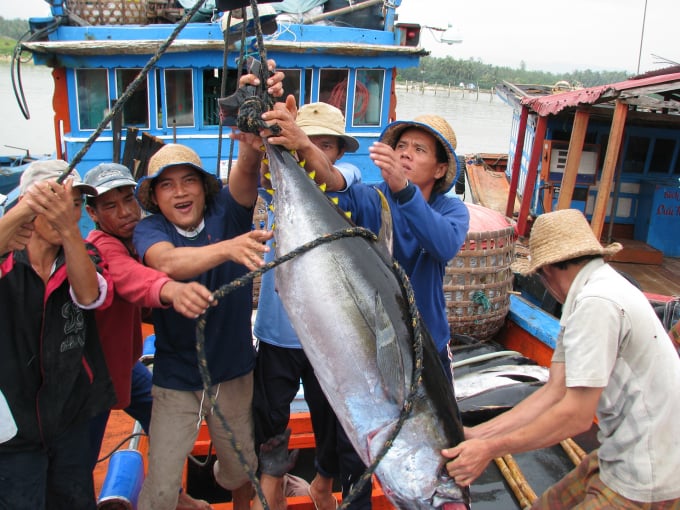November 28, 2025 | 02:53 GMT +7
November 28, 2025 | 02:53 GMT +7
Hotline: 0913.378.918
November 28, 2025 | 02:53 GMT +7
Hotline: 0913.378.918

Vietnam's frozen tuna meat/fillet has been competitive in Mexico thanks to the CPTPP.
Nguyen Ha, an expert in the tuna market of the Vietnam Association of Seafood Exports and Processing (VASEP) said that after the continuous plunge in the first three months this year, Vietnam’s tuna export to Mexico has climbed up relentlessly in the two following months. In May, tuna export value to the market hit USD 1.1 million, up 294% year on year, elevating the value of the total five months to Mexico to USD 4.8 million, up 3.8% interannually.
Mexico is one of the member markets in the Comprehensive and Progressive Agreement for Trans-Pacific Partnership (CPTPP), in which Vietnam's frozen tuna meat/fillet products will be taxed under a 3-year roadmap, from the base tax rate of 20% to 0%.
According to the General Department of Customs, Vietnam is exporting the sole products of frozen tuna meat/fillet to Mexico. Over the past years, for Vietnamese imported products, Mexico had levied a high tax rate of 15% while that from Malta was 0%, Ecuador 9%, and European countries 0%. Therefore, Vietnamese frozen tuna meat/fillet found its struggle to compete with those from Malta and Ecuador. However, under the CPTPP commitments, Vietnamese frozen tuna meat/fillet products imported to Mexico enjoy 0% tax, drawing more attention from Mexican importers.
Exploiting the opportunities opened by CPTPP, some enterprises namely BIDIFISCO, TITHICO, Hai Thanh Seafood are strengthening tuna exports to Mexico.

Fishermen in central Vietnam harvested tuna.
Canada is another CPTPP member market that saw impressive growth in Vietnam’s tuna imports. In the first 4 months of this year, Canada was the 4th largest single tuna export market of Vietnam, with a value of USD 11.56 million, up nearly 58% over the same period last year and accounting for 5% of the total export value of tuna exports.
With tariff incentives under the CPTPP and the impact of the Covid-19 pandemic, Vietnam's exports of processed and canned tuna to Canada are on a strongly onward trend, with an increase of 150% over the same period in 2020. Besides, exports of frozen tuna meat/fillets to Canada also increased by 24%.
Canada is listed among the top 20 largest tuna exporter markets in the world. Of which, processed and canned tuna made lion’s share of 85% of total export value. In the first quarter of this year, Canada's imports of processed and canned tuna continued to grow at 25% year on year.
Vietnam is the third-largest source of processed and canned tuna to the Canadian market in the first quarter of this year. Although the market share is still very modest compared to Thailand, while Vietnam's exports to Canada increased in the first quarter of 2021, Thailand's exports decreased.
In the past 5 years, Canada has always been one of the ten main force tuna export markets of Vietnam. Vietnam's tuna exports to this market have increased continuously at double-digit rates from 2017 until now.
Tuna was among those seafood contributing to Vietnam export turnover of USD 4.1 billion in the first half of this year. According to VASEP, by the end of June 2021, Vietnam's export turnover of other seafood products besides pangasius reached USD 1.6 billion, up 16% over the same period in 2020.
Seafood accounts for nearly 40% of exports in the first 6 months of this year; in which, tuna exports reached USD 364 million, up 24% over the same period in 2020. Exports of squid and octopus reached USD277 million, up 15% over the same period last year. Other types of fish reached USD 847 million, up 13%.
Truong Dinh Hoe, General Secretary of VASEP said that squid, octopus, and tuna are all having strong growth momentum in most major markets. In recent months, the US market increased imports of Vietnamese tuna 1.5 times over the same period last year, so in the first half of the year, tuna exports to the US increased by 23%. The US is consuming 43% of Vietnam's tuna.

(VAN) China’s cooking oil is suddenly flooding into India. It all comes down to a soybean surplus that Beijing doesn’t quite know what to do with.

(VAN) An Giang promotes supply-demand connections, standardizes quality and builds value chains, creating a foundation for sustainable bird’s nest development and aiming to expand exports.
/2025/11/24/5339-4-nongnghiep-075331.jpg)
(VAN) Recently, the conference on 'Sustainable Fisheries Linkage Chain - Tilapia for Export' took place in Tien Hai commune, Hung Yen province.
/2025/11/21/4309-2-153400_128.jpg)
(VAN) Green and low-emission rice is paving the way for Vietnamese rice to enter high-end markets, marking the beginning of a transformation journey toward greening and elevating the national rice brand.

(VAN) ‘Right to Win’ outlines a national action plan that shapes a new vision for Viet Nam’s agriculture in an era of renewal and global integration.

(VAN) Lam Dong’s farmed sturgeon output this year is expected to reach 2,300 tons, worth VND 450 billion, affirming the brand’s position on the market.

(VAN) A surge in Ukrainian egg exports, largely driven by soaring sales to the UK over the last few years, has notably pushed up egg prices on the domestic market.